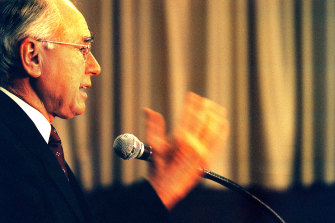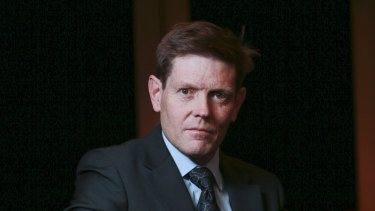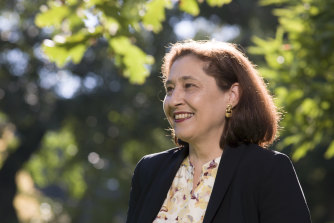At a media conference 20 years ago, former prime minister John Howard announced what he said was the biggest single export deal in Australia’s history, a 25-year contract to supply China with up to $25 billion worth of liquified natural gas from the North West Shelf.
Howard was excited. It was, he declared, “a gold-medal performance”.
John Howard announcing the liquified natural gas contract in 2002.Credit:Rob Homer
Trouble was, the contract locked in Australian gas sales to China at a historically low price. As the world price of LNG began to climb, it quickly became apparent just how rotten the deal was (at least from Australia’s perspective).
As one industry figure who was part of the original negotiations told the Australian Financial Review in 2015: “It is regarded as the worst deal ever done.”
Nevertheless, the Rudd and Gillard governments likewise announced a series of huge contracts to ship Australian gas to China, South Korea and Japan (although unlike the original Howard-era contract, prices tended to be tied to global oil prices).
Since Howard made his announcement, the volume of LNG exports has rocketed by 875 per cent, and the value has increased by 1041 per cent, according to figures from the Department of Industry, Science and Resources.
Australia is now shipping out about three-quarters of the gas it produces. In 2019-20, we produced 5945 petajoules, of which 4393 petajoules, or 74 per cent, went overseas. That left 1647 petajoules that was used in Australia for domestic purposes during the year, including for power generation, heating and manufacturing.
Unbelievable though it is for a country with such plentiful supplies of gas, Australia’s east coast is now caught in the grip of an energy crisis.
In recent weeks, the market operator has been forced to stage a series of dramatic interventions to stave off winter blackouts. Meanwhile, consumers, already under the pump from cost of living pressures, are facing higher energy bills.
How on earth did it come to this?
Talk to energy market analysts and state and federal governments, and they’ll tell you there is no single reason.
Australia’s fleet of coal-fired power stations are being plagued by maintenance issues.Credit:Jessica Shapiro
It’s been an unusually cold winter on the east coast, pushing up demand for energy for heating. Australia’s ageing fleet of coal-fired power plants is starting to break down, placing additional pressure on gas to fill the void. Victoria’s gas fields in the Bass Strait are beginning to run low and power generation from wind and solar has, at times, fallen short this winter.
All the while, global spot prices have been soaring, with Europe shunning Russian gas imports in response to Vladimir Putin’s invasion of Ukraine.
Normally, gas is supposed to step up to meet peaks in power demand. The advantage of a gas turbine is that it can be switched on at short notice, unlike a coal-fired plant, which can take days to crank up. But Professor Bruce Mountain, director of the Victoria Energy Policy Centre, said gas was increasingly been used as an inefficient source of base-load power.
Bruce Mountain, director of the Victoria Energy Policy Centre.Credit:Wayne Taylor
“Gas has been forced into the market and it’s being used to produce a great deal more electricity than it normally does,” Mountain said this week.
Demand for gas has been so strong that Lochard Energy’s massive Iona gas storage facility, located in Victoria’s south-east near Port Campbell, has been emptying at an alarming rate. The Australian Energy Market Operator (AEMO) was last week forced to step in, warning low pressure at the facility could jeopardise the effective operation of the east coast market.
The problem is gas-dependent Victoria is currently the only state in which a $40-per-gigajoule price cap on gas remains in place to tamp down on high wholesale prices.
The cap, which was triggered automatically at the end of May under Australia’s gas market rules, prompted NSW and Queensland to get more of their gas from the Iona facility, which is the largest independent provider of storage services to the east coast gas market.
Lochard Energy’s Iona underground gas storage plant in Victoria is being drained to dangerously low levels.
That prompted AEMO to trigger the so-called gas supply guarantee, allowing it to order Queensland suppliers to send more gas to NSW to free up gas for Victorian power generation.
That intervention came just weeks after AEMO made the unprecedented decision to briefly suspend the whole east coast electricity market to avoid winter blackouts.
Australia has enough gas, for now. But clearly, the energy supply network is a mess.
Victoria’s Energy Minister Lily D’Ambrosio said it was clear additional “immediate measures” were needed to head off a supply crisis, including giving AEMO even more muscle to set guaranteed minimum gas storage levels at key national storage facilities such as Iona.
That would act as a sort of proxy curb on exports, forcing gas producers to store more of the resource locally rather than cashing in on soaring world demand.
But D’Ambrosio is well aware this would only represent a Band-Aid solution.
Longer term, Victoria and other jurisdictions want a domestic gas reservation policy, which would force gas producers to set aside a proportion of LNG production for domestic use, helping to keep a lid on prices. Such a reserve has been in place in Western Australia since 2006, with 15 per cent of gas produced in the state kept for domestic use.
The issue will come to a head at an August 15 meeting of state and federal energy ministers.
Lily D’Ambrosio, Victorian Minister for Energy, Environment and Climate Change, wants a domestic gas reservation policy.Credit:Elke Meitzel
Alan Carpenter, the former WA premier responsible for the 2006 policy, told The Sydney Morning Herald and The Age last month that it was unfathomable that the model had not been copied in other parts of the country.
But for many gas producers, the situation is not so simple. They say it can take years to release returns on investments.
David Maxwell, managing director of Cooper Energy, which supplies the Victorian market from gas fields in the Gippsland and Otway basins, strongly disputes D’Ambrosio’s claim that gas producers have been “getting away with too much”.
Maxwell argues that without the economies of scale linked to Australia’s massive LNG export markets, Queensland’s coal seam gas fields would simply not be economically viable.
He said last week: “The LNG (export) industry has enabled more supply.”
The Morning Edition newsletter is our guide to the day’s most important and interesting stories, analysis and insights. Sign up here.
Most Viewed in National
From our partners
Source: Read Full Article




